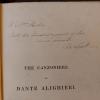Narrating Dante's Life and Love Through His Lyric Poetry
External links
Commentary
Taylor Institution Library, VET.ITAL.IV.A.69
Poesie di Dante Alighieri precedute da un discorso sulla loro legittimità, ed. Pietro Fraticelli (Florence: Allegrini e Mazzoni, 1834).
Taylor Institution Library, 51.E1.1
Il Canzoniere di Dante Alighieri, annotato e illustrato da Pietro Fraticelli aggiuntovi le rime sacre e le poesie latine dello stesso autore
(Florence: Barbèra e Bianchi, 1856).
Bodleian Library, 288.g.57
In Amori e rime di Dante Alighieri (Loves and Lyrics by D.A., ed. Ferdinando Arrivabene [Mantua: Caranenti, 1823]), as its title suggests, the poems of the Vita Nuova and the other lyric poems were ordered and interwoven in order to tell the story of Dante’s love for Beatrice, explained in length by Arrivabene.
The editions of Dante’s lyric poetry by Pietro Fraticelli (1834 and 1856, with several reprints of each) soon became widely appreciated and read, and thus their canon of Dante’s lyric poems became the most famous. The 1834 edition is entitled Poesie di Dante Alighieri (Poems by D.A.) and collects all the short-form poetry by Dante. Fraticelli’s second edition of Dante’s poems (1856) bears the title of Canzoniere, “songbook” or “book of poetry,” a novelty which had appeared in the 1835 English edition by Charles Lyell (The Canzoniere of D.A.), which is the first translation of Dante’s lyric poetry into English. In Fraticelli's 1856 edition, the poems are divided into three groups: the legittime (legitimate poems), in turn sub-divided into canzoniere erotico (erotic songbook) and canzoniere filosofico (philosophical songbook); the dubbie (uncertain poems); and the apocrife (apocryphal poems).
Such a categorisation and ordering of Dante’s lyric poetry into overly coherent thematic songbooks does not merely emphasize its ties with the life of the author – it promotes, especially through the concoction of an “erotic songbook”, an interpretation of Dante’s literary experience as a direct reflection of his life experience. Out of poetic pieces which were written for the most part as independent poems, it creates a new literary work that was never planned by the author of those pieces. The understanding of the lyric genre as a direct mirroring of one’s self, which continues to encapsulate what lyric poetry largely still is for us today, became predominant from the beginning of the nineteenth century, with Romanticism. However, this reading is not easily applicable to writings from the Middle Ages, when literature did not carry the same meanings as it does for us today, and poetry was a discipline at the threshold of philosophy and rhetoric.

